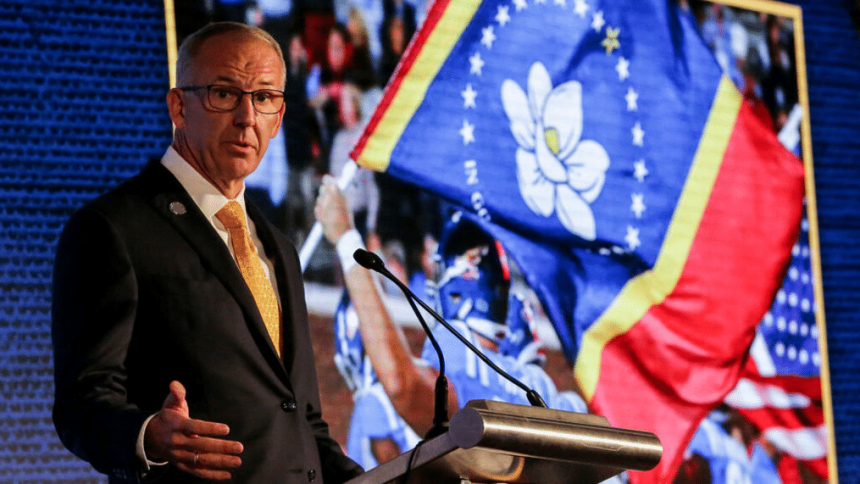Not many people were busier than SEC Commissioner Greg Sankey this week during SEC Media Days. Between a return to more normal operations after a year of uncertainty during the ongoing COVID-19 pandemic. But with COVID-19 cases on the rise once again and a historic shakeup of the NCAA possibly on the horizon, there are many issues facing college football.
Sankey sat down with SportsTalk Mississippi to share his thoughts on the current issues facing the SEC including the pandemic, name-image-likeness rights, but also what he enjoys about SEC football each Saturday.
SEC commissioner Greg Sankey met with the media on Monday at SEC Media Days. Here’s everything he said as he kicked off the annual meeting in Hoover.
GREG SANKEY: Good morning, everyone. Welcome back to SEC Football Media Days. Start with a couple of important comments first. Thank you to everyone who’s made this week happen, our friends here at the Winfrey and the city of Hoover. This was another one of the quicker pivots we’ve had to go through in the last year and a half, and their work is much appreciated.
I also was here yesterday at the podium. We do a little bit of a sound check, and I remember three years ago when I was here, I was going to ask for a wider podium so I could manage my notes better, and I lost that task over the last year, so my discomfort at managing notes up here is real.
But on to the more important things. When I was standing here in 2015, it was my first time to be the commissioner for SEC Football Media Days, and I opened with a song lyric from Bob Dylan way back in 1963, “The Times They Are a-Changin’.” You may recall that Dylan spoke of you in one of the verses in that song: Come writers and critics who prophesize with your pen. Keep your eyes wide open, the chance won’t come again. And don’t speak too soon for the wheel’s still in spin, and there’s no telling who that it’s naming, because the loser now will be later to win, for the times they are a changin’.
If you wonder if I pick songs that have some meaning, I think I got that one right, maybe a little early because the times are changing.
It was in Nashville, March 12th, 2020, the last time I stood in front of a room of reporters, and I recall that day because we had to do the unimaginable in the Southeastern Conference, we stopped everything. No more games in our men’s basketball tournament, no baseball games, no softball games, no tennis matches, golf tournaments, track and field meets. No National Championships would be played for the rest of that year. It’s a reminder that not only do the times change, but the times change quickly.
As we worked through COVID issues last summer, we experienced not simply the greatest public health challenge of our lifetime, we also saw issues of inequity and injustice play out on the front pages and on the streets across our country. Our student-athletes were leaders, just as they are every day, as they marched, talked, engaged, learned, and sought change, and I’m proud of their commitment to thoughtful, meaningful action.
Their actions produced change in the state flag of Mississippi, to a flag that had flown over that state for over 100 years. We had coaches on videoconference speak of never having voted during their time as a student-athlete, stating unequivocally that would not happen on their team moving forward.
Fast forward to August 10th, when it was clear several of our colleague conferences were not going to move forward with a fall season, and the SEC, informed by our medical advisory task force and guided by our leaders, I simply and honestly announced: Can we play? I don’t know. We haven’t stopped trying, and we will continue to do so every day.
The potential absence of college football and the reality of an abbreviated season with limited attendance made us all realize how much we appreciate college football, what it means across our nation, but most importantly, I think we saw what it means to the young people who participate in the game of college football.
We had to reimagine a season, how to start again after stopping, how to play the games in the COVID environment, and how to begin when a team was disrupted. We had to make that change happen, and I’m proud of the role the SEC played in making certain there was 151st consecutive season of college football.
In December, the SEC and Disney announced a forward-looking new media agreement that represents change from our relationship with CBS, but when fully in effect in 2024, we’ll actually have more games available on broadcast TV via ABC. Right now we’ve had some local decision-making to place game times for games that will be distributed on ESPN+, which is an acknowledgement of our access to digital technology and use of ESPN’s platform for direct to consumer access.
And we’ll still have access to ESPN’s many platforms, including the SEC Network, and in ’24, again, when in full effect, we’ll be able to announce more game times earlier, like in the summer, so that our fans and our schools have the ability to plan well in advance of the season.
In March of this year, our women’s basketball student-athletes and coaches were rightly outraged about the inequities that became apparent around the NCAA Tournament in San Antonio.
On June 21st, the Supreme Court issued its decision in the Alston case, making it clear that the status quo in college athletics is not an option, and on July 1st, student-athletes began their activity around name, image, and likeness opportunity.
All of that illustrates our reality that we must change, but as we think about change, we must remember that not everything is broken around college sports. We need a reminder about the many positive realities that don’t receive full or accurate attention because we need to work, we need to understand what works well and what needs to be sustained as we look towards the future in this expectation of change.
So let’s start with the Olympics. According to the United States Olympic Committee and Paralympic Committee, there are 613 United States Olympians. 463 of those had a college athletics experience. And that will include 80 current or former SEC student-athletes, and we’re one of three conferences where all 14 of our universities will be represented by at least one Olympian, and there’s not a football player among that group.
Our national college sports system makes that happen. If you change college sports, you change our Olympic development and support system in this country.
When we were faced with the economic fallout from a revised schedule, a delayed start, reduced fans, reduction in ticket sales, we didn’t back away from our responsibilities. In fact, we as a conference stepped up. In the SEC we did not have any sports dropped or discontinued in our athletics programs, and well before there was an NCAA rule introduced, our conference acted to assure those student-athletes who decided to opt out of playing that they would retain their financial scholarship through their athletics program.
The result was we had 185 student-athletes opt out who enjoyed that support from their university.
And while we’re talking about accurate data around college athletics, understand that our student-athletes don’t go hungry. There are no limits around the nutritional support provided to our student-athletes.
There’s also been misrepresentations of what happens when a student-athlete is injured. Understand, when a young person enrolls on our campuses to participate in college athletics, they as a matter of standard practice go through advanced medical screenings. The reality is young people have maladies detected through that process that for the first time are frequently treated.
And when we have injuries in college sports, our student-athletes have access to world-class physicians and the best rehabilitation support. And when a student-athlete is injured and no longer able to participate in their chosen sport, our universities willingly provide support under the NCAA’s Medical Exemption category. Last year that included financial support to 105 student-athletes in this league.
In addition to the financial support provided to student-athletes who are injured, unable to participate, or opted to not participate, we had 127 student-athletes supported by SEC athletics departments whose eligibility was complete before they completed their undergraduate degree. They were welcomed back willingly by our programs, not because of a rule or government mandate, because that’s how we care for young people.
And in any year there are more than 5,400 student-athletes supported through an athletic scholarship in the Southeastern Conference. Of that group, we saw 67 percent of our teams access National Championship postseason tournaments or playoffs. We had eight different — excuse me. We had eight different universities with nine teams earning National Championships.
So I’ll clarify that. What that means is more than half of our universities, eight, celebrated their own National Championship moment since January of this year.
The SEC produced 12 Players of the Year from our 21 sports. We had the NCAA Woman of the Year, a National Football Foundation Scholar Athlete, two Honda Sport Award winners, and I could go on with a list of individual accolades. And this happened because we tried when it was difficult, and it happens because of the world-class support provided to offer incredible athletic and educational experiences in the Southeastern Conference.
To make what happened last year take place, we had to create a conference-wide COVID testing program. That involved a third-party logistics and medical support team that included nearly 350,000 COVID tests. About 340,000 were lab-based PCR. That was our standard through the week, through every sport, regardless of the season, and another 10,000 rapid antigen tests. Right now 43 percent of our football teams, that’s 6 of 14, have reached the 80 percent threshold in roster vaccination. That number needs to grow and grow rapidly.
We have learned how to manage through a COVID environment, but we do not yet have control of a COVID environment, and that finds us preparing to return towards normal this fall, but we see realities around us.
Olympians are removed from participation because of positive COVID tests. The Yankees-Red Sox game last Friday was postponed. And sadly, our colleagues at North Carolina State weren’t able to continue the competition in the College World Series, which we cherish competition, particularly at that time of the year. But each reminds us of the need to be vigilant about our health.
Let me be clear to our fans, to our coaches, to our staff members, and to our student-athletes: COVID-19 vaccines are widely available. They’ve proven to be highly effective. And when people are fully vaccinated, we all have the ability to avoid serious health risks, reduce the virus’ spread, and maximize our chances of returning to a normal college football experience and to normal life.
With six weeks to go before kickoff, now is the time to seek that full vaccination. And we know nothing is perfect, but the availability and the efficacy of the COVID-19 vaccines are an important and incredible product of science. It’s not a political football, and we need to do our part to support a healthy society because, as we look back, the potential absence of college sports last year caused us to think about not losing sight of the lifelong experiences, the laboratory of learning that takes place, and the educational benefits that accrue to the people who participate on our teams.
But just like every human endeavor, college athletics is not perfect, and you know the criticisms, many of you have likely written those criticisms, and as leaders, we have a responsibility to improve our attention to genuinely identifying, addressing, and resolving the lingering issues.
Not everyone’s going to be pleased, and change takes time. However, if we understand both the strengths of college sports and the key areas to be addressed, we can work towards effective solutions.
But let’s leave the legislative issues and the COVID issues for just a few moments. We now have William Tate leading LSU as the SEC’s first African American president or chancellor. We have African American athletics directors. We have head coaches in men’s basketball and in women’s basketball from underrepresented groups.
Yet, after hiring eight new head football coaches in the past two years in the SEC, we have no underrepresented group leading one of our football programs. We have no head coaches from underrepresented groups. It’s a reality that has changed before, and it must change again.
So in early June, our presidents and chancellors approved a new initiative to establish an expectation for athletics department hiring processes around key leadership roles — athletics directors, senior administrators, and head coaches.
And while employment decisions are made, not by the conference office, but by our campuses and their athletics departments, this change will bring a collaborative expectation where, when these openings appear, we’ll be in communication, sharing information about potentially viable candidates from historically underrepresented groups.
To make certain our member institutions are fulfilling their expectations under this new policy, each year will be expected to write a written communication to the commissioner about their efforts to include diverse candidates in their finalists pool, and we’ll share this information with you a bit later today.
But as times change, we find ourselves not celebrating first downs, touchdowns, or championships, instead we talk about litigation, about legislation, and about lobbying. We are in a transformative time, perhaps the most transformative time in the entire history of college sports, and there must be recognition that this transformation can’t come from a set of siloed decisions. We have to understand the connection, the nuances, the implications, and the unimagined outcomes associated with decisions.
So let’s start first with a continuing point of criticism, and that’s the economics of college sports. However, as we adjust to different economic expectations around college sports activity, we all must understand the reality associated with whatever direction emerges. As I talked about a moment ago, will there be a college-based Olympic development and support system? Will opportunities be reduced as our colleges and universities slim down their sports offerings? What’s to be done with existing contractual, financial, and facility commitments?
If a new economic model is to be imposed or created, how are we to maintain a focus on improving educational outcomes, maintaining widespread interests, and supporting broad-based programs, and how do we adjust college sports within the boundaries of antitrust law?
Earlier, I mentioned a small piece of medical support for our student-athletes and made that specific to how we function, but a few years ago, the autonomy five conferences adopted an expectation, a requirement that two years after a student-athlete’s participation, our universities provide medical support through financial support for those student-athletes two years after they departed. Is that the right health care expectation for college athletics? If not, how should it change? Is it length of time? Is it substance of support?
And even as more young people graduate from our programs, how do we meaningfully foster career transition? We have programs at the conference office to help facilitate that. How do we expand that? How do our campuses perhaps become more intentional, have more flexibility at facilitating that career transition? What attention is owed to transfers who seek a greener pasture but instead lose their scholarship opportunity?
This year’s transfer portal had over 1,600 FBS scholarship recipients enter. There are still 1,100 active in that portal across all Division I sports, over 13,000 entered, and over 11,000 still remain. There’s not enough information for me to explain that data, but we have a responsibility to dig deeper because it’s not good enough just to provide flexibility. We have to understand the impacts of our decision-making.
We also have to understand how to support an environment that provides more flexibility, permits legitimate transfers, while holding to account those who tamper and want to turn college rosters into their personal recruiting grounds.
In December I sent a lengthy letter to the NCAA Division I Council. My purpose was to identify and make observations around the NCAA’s enforcement and infractions process that I felt had to be addressed sooner rather than later, and in each observation, I offered at least some form of suggestion to help guide us forward, perhaps not perfect suggestions but something to be considered, because we need to be clear. Those accused of violations deserve a fair and timely outcome, and those who compete against those accused of violations deserve that same fair and timely outcome.
And the national process for accountability must focus on issues of primary importance with cases resolved in the most timely manner possible. And it’s easy — in fact, I’ve been at fault — it’s easy to criticize the NCAA. It’s an organization of over a thousand different institutions at three different divisional levels. In Division I, there are 351 campuses, 32 conferences. That’s a difficult role.
But I was pleased by President Emmert’s call to reconsider the responsibilities of the national office of conferences and of campuses. While not knowing the path forward, we desire this necessary dialogue as it remains important for college athletics to have an effective governing body.
We often move forward producing legally defensible, relevant results and regulations. The most recognized, the expectations, demands, and pressures that are present on the campuses of this conference are not uniform across all of Division I, and expecting every conference to come together to debate, discuss, and produce effective decisions for everyone is not our modern reality. We must begin to adapt.
And as we witness realtime adaptation to the new name, image, and likeness environment, NCAA programs are already properly supporting student-athletes within the boundaries and expectations of state laws or of executive order. It’s a complex task that’s made challenging because everyone is operating according to different state laws.
But the NCAA’s temporary rules governing name, image, and likeness were a necessary reality, but those interim policies are no substitute for a uniform national standard. While we all will benefit from a standard that supports the interests of student-athletes while preventing exploitative practices with policies that can be understood and administered by universities and colleges at every level, while also providing prospective student-athletes with clarity as they are recruited nationally across state lines and have to understand the different name, image, and likeness laws. Because state laws are either inconsistent or nonexistent, the NCAA rules can no longer resolve key issues. We need a federal solution.
We understand it’s difficult to gather the support for such federal legislation. However, congressional action is necessary if we’re going to provide every student a clear, consistent, and fair opportunity to benefit from their name, image, and likeness.
The Southeastern Conference and our member universities are ready to engage in the collaborative problem-solving effort with all of college sports’ major stakeholders. Our present reality highlights the need for a national dialogue on what is expected of college sports, be it health care, educational certainty, career transition, examining the economics, or myriad other issues.
We in the SEC are dedicated to the shared values of higher education and high-level collegiate athletics competition while ensuring the unifying traditions and spirit of college sports remain interwoven in our nation’s campuses and our communities.
We must now take the additional step of ensuring student-athletes are provided with modern and reimagined opportunities to benefit from their participation in college sports.
Let me again say thank you for everyone who made it possible for us to be here today. Thank you for your flexibility since that date in March of 2020, when everything was going to Zoom. You remember people weren’t happy that we created that distance, but we did things that we had to do to make possible what we achieved.
Our staff is here and ready to help through the remaining days. As is our tradition, I’m going to turn it over to Kevin, but I’m going to leave you with this one last reminder. The times are changing. It’s not simply a song lyric, it’s a reality. It is an uncomfortable reality, but that’s how progress is made. Through it all, I remain convinced in the Southeastern Conference our best days are still ahead.
So, Kevin, I’m going to grab a drink real quick and throw it to you.
THE MODERATOR: Thank you, Commissioner. If you have a question, please raise your hand.
Q: Greg, last year with the postponements and moving around games, especially football, is that something that will not happen this year? Will you simply go — if a team cannot play, will they have a no contest or a forfeit?
GREG SANKEY: So let’s just indicate like the realities we deal with. You hope not to have disruption, but hope is not a plan is the great cliche. We still have roster minimums that exist, just like last year. What I’ve identified for consideration among our membership is we remove those roster minimums and you’re expected to play as scheduled. That means your team needs to be healthy to compete, and if not, that game won’t be rescheduled.
And thus, to dispose of the game, the “forfeit” word comes up at this point. That’s not a policy, and what you see are the bookends now for decision-making. We’ve not built in the kind of time we did last year, particularly at the end of the season, to accommodate disruption. And unless we’re going to do that, our teams are going to have to be fully prepared to play their season as scheduled, which is why embedded in my remarks is the vaccination motivation.
Q: It’s viewed that some SEC schools have a competitive and recruiting advantage over others because there is no uniform drug policy. Would the SEC benefit from a uniform drug policy?
GREG SANKEY: We’ve talked about that issue for years, and I give you credit because I don’t think I’ve had that question in like three or four years. So there’s a set of things that usually happen in Destin. That’s one of them. As Ross Dellenger knows, the alcohol question was always there, so that was his task. Which is not linked to your question, by the way, so I want to draw the distinction between the legal and the illegal.
We have not gone back into that conversation. Our member universities have felt it appropriate to allow each campus to make its own decisions around drug policy. Our universities have policies that extend even beyond our athletics program. So it’s not been a point of conversation.
Q: With all the changes in college athletics with the NIL and players transfer rule and whatever, are college commissioners closer than, say, five years ago, particularly the Power Five conferences, in splitting off into their own country, so to speak?
GREG SANKEY: I don’t know where — well, I guess I was commissioner five years ago. It’s been a long time. You try to give me a day off, and then throw that one at me on social media. No, that’s not the focus. I went through a list of observations that aren’t just NCAA related, they are college athletics related. That’s actually us. And some ideas — in fact, ideas that I’ve had — actually don’t resolve issues. They just linger.
So are we closer? Not in my imagination. I do think we all have to be mindful of the reality in front of us, and as I noted, when President Emmert spoke about the need for change and reimagining the national office role, the conference role, and the campus role, that doesn’t speak to your question, but it does speak to we’re going to have to administrator this differently.
That’s likely the next process. Yet, Ron, I think people are going to be asking that question of me. I think within our programs people will ask that question of me. I think nationally people will ask that question of me. But it doesn’t predict that kind of outcome at this point.
Q: Greg, you said we need a federal solution. I guess what, if anything, gives you the confidence that congress can actually deliver a solution to these issues?
GREG SANKEY: All I can do is keep asking and making the case for why it’s necessary, and I’ve learned over the last two years I should have paid much more attention in high school civics because I’m learning much. The Schoolhouse Rock “I’m Just a Bill” video was like my expertise, and it’s magnified. There is no assurance. I hope — and I’ve testified once, I’ve met, I’ve had conferences to provide some education and perspective about what that national standard would mean.
We also, and I’ve said here, are willing to discuss other aspects that may be on congressional leaders’ minds. I don’t know if we can resolve every one of them through federal legislation, nor, given the level of care, do I think every element needs to be regulated. I do think every element needs to be understood.
So, John, do I have assurance? Can I predict an outcome? I cannot. If that’s where we are, we’re going to be dealing with this tension, we’re going to learn a lot. Obviously, we have in the last three weeks, we’ll learn a lot the next three months, and we’ll see how that guides us if, in fact, there is no federal legislation.
But think about some elements that I mentioned. Start with the prospective student-athlete who’s recruited by our universities. That’s going to be somebody recruited nationally. How do they and their family understand what name, image, and likeness policies are going to apply upon their collegiate enrollment. States are all different, or they don’t have anything, and they’ve just been given permission. So some level of institutional policy provides.
When you examine state legislation, there’s not a high level of oversight. And I just read on Twitter some really high number of businesses that are now in this space. Yeah, there are businesses that are well intentioned that will support young people, but outside our league at different levels, I’ve heard of young people walking into compliance offices with contracts that say pay so-and-so $5,000. They’ll create your brand and your website, or $10,000, or $15,000. That’s not this one-sided flow of money that everyone expects. So how do we oversee this properly?
If the outcome of the Alston case is we have to be less restrictive in NCAA rules, then we’re back in this conversation about congress. That’s the difficulty of being a conference commissioner, an athletics director, or a compliance coordinator right now.
And I will give you a point of praise because you asked a question that was actually really important last July at this time, end of Paul’s show — and congratulations to Paul on a contract extension being announced — you asked why are we trying to play college football? You provided me lack of sleep that night because that’s the kind of question that should have been asked, and I worked with a lot of people to try to answer why we needed some clarity. Hopefully people are convinced we did it well, we did it right, and that’s an appropriate step. I’m not blaming it on you, John, but I just give you credit for raising an issue that cost me some sleep to try to figure out a path forward a year ago.
Q: You talked about COVID and the need for vaccination, but as cases continue to rise in different parts of the country, are you coordinating with other schools, for example, with LSU’s season opener against UCLA and the county reinstating a mask mandate, what are the conversations like as far as attendance and roster management goes?
GREG SANKEY: A couple aspects. One, there is still communication among the conferences, particularly the five conferences, and our medical leaders. That began last May. It was incredibly beneficial and will continue now. Our campuses who are traveling to those non-conference games are going to be in communication with the host and the host community to understand what policies will apply.
Chicago, for example, had no vaccination out of state travel limitation on the states of Missouri and Arkansas announced last week.
What we’ll see, I expect, is municipalities and public health officials, perhaps at the state level, continuing to adjust, which brings me back to the mantra of last year, which is we’re going to prepare to play the season as scheduled, and I’m convinced we’ll move forward to the Labor Day weekend start, unlike last year, but we will have to adapt to the circumstances of COVID-19, of the virus. That’s where I talk about we know how to manage through, but we don’t have control of the COVID environment.
Q: Given President Emmert’s comments about many responsibilities falling more and more on the conferences, at the conference level, will that include enforcement? What is the current status of NCAA enforcement? And given nobody seems to know exactly what the rules are until they’re hashed out, is there still even a working enforcement staff?
GREG SANKEY: Oh, absolutely. In the midst of trying to make observations to move the process forward, Cecil, I’ve communicated in meetings and settings — I think highly of John Duncan, the NCAA’s president of enforcement. That’s an incredibly difficult role, and the enforcement staff has a difficult role.
Let’s take a step back. Let’s understand in 2018 the Commission on College Basketball introduced a new process, an independent review process. That process hasn’t reduced outcomes from arrests made by the FBI in September of 2017, and some of those acts of alleged wrongdoing occurred back in 2016. So we’re now five years removed without outcomes. We need outcomes, particularly from those high profile matters.
The enforcement staff, the Committee on Infractions are still active because we have had matters resolved. I think there was one announced last week, didn’t involve this conference.
But we need to readjust our expectations, and if you look over time, there have been a set of individual working groups that have introduced change. So the Commission on College Basketball, most recently, the Enforcement Working Group ten years ago. There was a Duff report. There was a league commission. How do those all connect?
And the rhetoric around what we need is more aggressive penalties, I would argue, doesn’t work. What would work more effectively might be reduced penalties but specific time expectations to implement those penalties while slimming down the focus to that which is of primary concern for the support of college athletics.
I’ll give an illustration. A college coach that walks into a high school and has a conversation with a high school junior. We’ve had universities spend six figures defending coaches in that. We’ve had potential head coach suspensions for an interaction.
If we want to foster a college-going culture through college athletics, why wouldn’t we allow those conversations to take place in football? They can take place in different ways in basketball. Stop spending time, the opportunity cost associated with that enforcement and focus on the primary issues.
So, yes, there is the role. An incredibly hard job. I have a lot of respect for those leading in that work, but we have to have timely outcomes, particularly in high-profile matters. And I spoke of fair and timely, which I think is a two-way street in this process.
Q: Commissioner, you talk about a lot of these changes that need to be made and trying to make progress on that, but with so many different voices in the room and trying to get everybody on the same page, one, how do you get to that point where you get everybody in the same room and start making progress? And secondly, is there also an onus on, say, the commissioners and, for that matter, the university presidents who maybe haven’t been as vocal as we’ve seen some commissioners?
GREG SANKEY: I’m not convinced you can put everyone in a room and have the needed outcomes. It doesn’t mean everyone’s just detached, but it may be that we have to first identify the principles for change. That informs some elements of change that brings about a process for change.
As I said, I don’t know the path forward. We have a responsibility, almost to Cecil’s question, as things are delegated, you take enforcement. We had an investigator 20 years ago or 15 years ago, 17 years ago is when it stopped, because it didn’t work effectively. The Pac-12 had its own process, kind of double jeopardy. That’s gone away. So there are roles.
In answering your question directly, I think some high-level thought focused on specific elements is at the core of this, and we can add, but we’re not going to solve every problem and be able to legislate college athletics programs through the NCAA manual. We can govern some aspects, but 450 pages seems less relevant today than it ever has before.








